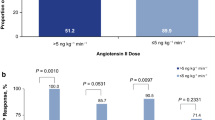Abstract
Summary. Tolerance to nitroglycerin infusion (NG) can be overridden by dose escalation. The aim of this study was to define for how long it can be done for hypotensive efficacy of NG, in a coronary care setting.
A prospective trial with an intra-individual therapeutic comparison was performed in 60 patients with acute myocardial infarction or unstable angina. Initial efficacy of NG was confirmed by a 10% blood pressure decrease (measured by cuff). Seventy-two-hour NG infusion was interrupted, for 30 minutes, every 12 hours. If blood pressure increased by 10% after infusion interruption, the infusion was continued at the previous rate. If blood pressure did not increase (detected tolerance<197>weakened efficacy of NG), the dose was increased until pressure decreased by 10% and the infusion was continued at the new dose. Failure to achieve hypotensive response, despite a 5-fold dose increase, indicated onset of resistance<197>completely lost hypotensive efficacy of NG.
The majority of patients (49 out of 55) who developed tolerance, developed it during the first 36 hours, while the majority of those who developed resistance (33 out of 40), developed it within 60 hours of the infusion. Tolerance was overridden by dose escalation in 41 out of 55 patients, which was repeated in 31 patients. Complete restoration of NG action was possible over 24 hours in half the patients, and over 48 hours in one third of the patients. Three out of 34 patients who developed tolerance before the 13th hour did not develop resistance during the following 60 hours of dose up-titration.
The conclusion is that tolerance to NG can be overridden by dose escalation in the majority of patients for a significant period of time, which is useful in clinical practice.
Similar content being viewed by others
References
Rapaport E. Pharmacologic therapy for acute myocardial infarction. Which agent, how much, how soon, how long? Postgraduate Med 1997;102:143–145.
Thadani U. Secondary preventive potential of nitrates in ischaemic heart disease. Eur Heart J 1996;17(Suppl F):30–36.
Thadani U. Nitrate tolerance, rebound, and their clinical relevance in stable angina pectoris, unstable angina, and heart failure. Cardiovasc Drugs Ther 1997;10:735–742.
Jugdutt Bl, Warnica JW. Tolerance with low dose intravenous nitroglycerin therapy in acute myocardial infarction. Am J Cardiol 1989;64:581–587.
Dupuis J, Lalonde G, Lebeau R, Bichet D, Rouleau JL. Sustained beneficial effect of a seventy-two hour intravenous infusion of nitroglycerin in patients with severe chronic congestive heart failure. Am Heart J 1990;120:625–637.
Thadani U, Opie LH. Nitrates for unstable angina. Cardiovasc Drugs Ther 1994;8:719–726.
Milicevic G. Molecular mechanism of glyceryl trinitrate action and tolerance development. Acta Pharm 1992;42:1–8.
Robertson RM, Robertson D. Drugs used for the treatment of myocardial ischemia. In: Hardman JG, Limpbird LE, eds. Goodman & Gilman's the Pharmacological Basis of Therapeutics, 9th ed. New York: McGraw-Hill, 1996:765.
Kaplan KJ, Taber M, Teagarden JR, Parker M, Davison R. Association of met-hemoglobinemia and intravenous nitroglycerin administration. Am J Cardiol 1985;55:181–183.
Makhoul N, Dakak N, Flugelman MY, et al. Nitrate tolerance in heart failure: Differential venous, pulmonary and systemic arterial effects. Am J Cardiol 1990;65:28J–31J.
Dupuis J, Lalonde G, Lemieux R, Rouleau JL. Tolerance to intravenous nitroglycerin in patients with congestive heart failure: role of increased intravascular volume, neurohumoral activation and lack of prevention with N-acetylcysteine. J Am Coll Cardiol 1990;16:923–931.
Milicevic G, Vrhovac B, Planinc D. A dynamical model for the separation of secondary resistance from tolerance to nitroglycerin infusion. Int J Clin Pharm Ther Toxicol 1993;31:12–17.
Zimrin D, Reichek N, Bogin KT, et al. Antianginal effects of intravenous nitroglycerin over 24 hours. Circulation 1988;77:1376–1384.
Milicevic G, Planinc D, Planinc-Peraica A, Vrhovac B. A high incidence of tolerance to hypotensive effect of low nitroglycerin dose detected by cyclic interruption of a nitroglycerin infusion. Croat Med J 1993;34:60–65.
Karlberg KE, Saldeen T, Wallin R, Henriksson P, Nyquist O, Sylven C. Intravenous nitroglycerin reduces ischaemia in unstable angina pectoris: double-blind placebo-controlled study. J Int Med 1998;243:25–31.
Varriale P, David WJ, Chryssos BE. Hemodynamic resistance to intravenous nitroglycerin in severe congestive heart failure and restored response after diuresis. Am J Cardiol 1991;68:1400–1402.
Thadani U, Sharma M, Thompson D, Prasad R, Goli V, Corn C. Intravenous nitroglycerin and tolerance in unstable angina. Circulation 1987;76(Suppl IV):IV-128.
Author information
Authors and Affiliations
Rights and permissions
About this article
Cite this article
Milicevic, G., Goldner, V., Vrhovac, B. et al. How Long Can an Escalation of Dose Override Tolerance to the Hypotensive Efficacy of Nitroglycerin Infusion in Coronary Care Patients. Cardiovasc Drugs Ther 13, 531–536 (1999). https://doi.org/10.1023/A:1007831821716
Issue Date:
DOI: https://doi.org/10.1023/A:1007831821716




